Key Takeaways:
To build a Doorstep EV Charging App Like Hopcharge, redefine convenience by bringing electric vehicle charging directly to users’ locations, anytime and anywhere.
With the global EV software market projected to surpass $1 trillion by 2032, now is the best time to invest in on-demand EV app development.
The cost to build an EV software like Hopcharge ranges from $20,000 to $150,000, based on features and technology used.
Key challenges include managing real-time charging requests, optimizing fleet operations, and ensuring smooth connectivity.
Emerging EV app trends like AI route optimization and IoT integration are driving the next phase of smart, on-demand EV charging.
As a leading electric vehicle software development company, JPLoft helps you build high-performance, scalable, and sustainable EV charging apps like Hopcharge.
Imagine launching a platform that lets EV owners skip the hassle of visiting charging stations by bringing power directly to their doorstep. It sounds futuristic and already transforming the EV industry.
As an entrepreneur, you might be wondering, “How to Build a Doorstep EV Charging App Like Hopcharge?” A solution that not only simplifies charging but also positions your business at the forefront of the green mobility revolution.
The answer lies in blending smart mobility solutions with user convenience through innovative app development. When you develop an app like Hopcharge, you’re not just creating a service; you’re fueling the future of eco-friendly transportation.
These on-demand EV charging apps are redefining how users access clean energy, offering real-time tracking, seamless payments, and hassle-free bookings.
Let’s uncover how you can turn this sustainable idea into a high-performing EV charging app.
What is the Doorstep EV Charging App Like Hopcharge?
Let’s picture this: It’s a busy weekday morning, your EV battery is flashing red, and the nearest charging station is miles away. Instead of panicking, you simply open an app, book a quick doorstep charging session, and relax while a mobile charging van drives to your location.
Within minutes, your EV is fully charged, ready to hit the road again. That’s exactly what a doorstep EV charging app like Hopcharge does: it brings energy to you instead of making you go to it.
In simpler words, it’s an on-demand platform that lets users book, track, and pay for EV charging services anytime, anywhere. But the real magic happens behind the scenes, through powerful Electric Vehicle software development.
The app connects EV users with charging fleet operators, manages schedules, tracks real-time vehicle location, and handles secure payments, all in one seamless ecosystem. Hopcharge, for instance, has redefined convenience for EV owners by turning a simple mobile app into a complete mobility solution.
It’s not just an app, it’s a smart network that combines technology, sustainability, and customer convenience. With such innovation leading the way, it’s easy to see why doorstep EV charging is becoming the next big leap in the electric mobility revolution.
EV Charging App Market Statistics & Growth Trends
The global shift toward sustainable transportation is fueling rapid growth in the EV charging and mobile app ecosystem.
Here’s a quick look at how the industry is expanding and what the numbers reveal:
-
According to Allied Market Research, the global EV charging software market was valued at $1.1 billion in 2023 and is expected to witness remarkable growth, reaching $11.1 billion by 2032, with a CAGR of 28.9% from 2024 to 2032.
-
Similarly, a report by Global Market Insights highlights that the EV charging management software platform market, valued at $2.8 billion in 2024, is projected to expand at a CAGR of 23.1% between 2025 and 2034.
-
Interestingly, more than 60% of EV users now interact with their vehicles through mobile applications, making EV apps one of the most promising opportunities in the tech and mobility space.
-
Meanwhile, Statista predicts that the global electric vehicles market will generate an impressive $784.2 billion in revenue by 2025, showcasing the sector’s massive potential.
-
Additionally, Introspective Market Research reveals that the electric vehicle software market, valued at $312.37 billion in 2024, is expected to reach $1,119.58 billion by 2032, growing at a steady CAGR of 17.3% during the forecast period (2025–2032).
Together, these statistics clearly reflect how rapidly the EV ecosystem is evolving, driven by digital innovation, sustainable practices, and rising consumer adoption worldwide.
Why Build an On-Demand EV Charging App Like Hopcharge?
The EV revolution is accelerating, and convenience is becoming the driving force behind its success. If you’re planning to build an On-Demand EV Charging App like Hopcharge, here’s why it’s the right time to jump in:
-
Growing EV Adoption Worldwide: With millions of electric vehicles hitting the roads, the demand for accessible and on-demand charging is at an all-time high. Businesses that make a Doorstep EV Charging App like Hopcharge can tap into a rapidly expanding market.
-
Unmatched User Convenience: No more waiting at public charging stations! A Hopcharge-like solution offers EV users doorstep service, real-time tracking, and digital payments, all at their fingertips.
-
Innovative Business Opportunity: Entrepreneurs exploring new Electric Vehicle app ideas are finding great success in doorstep charging solutions. It’s a smart blend of technology, sustainability, and profitability.
-
Sustainability & Green Mobility: Building such an app supports eco-friendly goals by reducing unnecessary trips and ensuring efficient energy usage. It’s innovation with purpose!
-
High Revenue Potential: Through subscriptions, partnerships, and pay-per-use models, Hopcharge-like app development can generate a steady income while strengthening your brand in the EV ecosystem.
In short, creating a doorstep EV charging app isn’t just about convenience; it’s about leading the charge toward a smarter, cleaner, and more connected future.
Key Features of a Doorstep EV Charging App Like Hopcharge
When it comes to developing an EV charging platform, “features” play a huge role in defining user experience and app success. After all, if you want to make a doorstep EV charging app like Hopcharge, your app needs to be simple, smart, and seamless to use.
These electric vehicle app features are the backbone that transforms a good idea into a great on-demand service.
Let’s take a look at the must-have features your app should include:
|
Feature |
Description |
|
User Registration & Profile Management |
Allows users to easily sign up, create profiles, and manage vehicle details for a personalized experience. |
|
Real-Time Location Tracking |
Enables users and service providers to track the live location of charging vans for accurate arrival updates. |
|
On-Demand Booking |
Let's users schedule charging sessions anytime, anywhere with flexible time slots. |
|
Secure Payment Gateway |
Supports multiple payment modes like cards, wallets, and UPI for hassle-free transactions. |
|
Push Notifications & Alerts |
Keeps users informed about booking status, estimated time, and offers in real-time. |
|
Charging History & Analytics |
Displays previous charging sessions, costs, and energy usage for user transparency. |
|
Fleet Management Dashboard |
Helps admins manage drivers, vehicles, and route optimization for smooth operations. |
|
In-App Support & Chat |
Provides instant help and assistance to users for a better experience. |
|
Review & Rating System |
Allows customers to share feedback, helping businesses improve service quality. |
|
Admin Panel & Analytics |
Gives business owners insights into performance, revenue, and customer behavior. |
These powerful app features ensure that your app isn’t just functional but also futuristic.
By integrating intuitive design, real-time data, and automation, you can deliver an app experience that rivals Hopcharge, one that users can truly rely on for convenience and confidence.
How to Build a Doorstep EV Charging App Like Hopcharge: Step-by-Step Process
Wondering how to build an on-demand doorstep EV Charging App like Hopcharge and turn your innovative idea into a profitable EV charging solution? You’re in the right place! Building such a platform requires careful planning, the right tech stack, and a user-focused approach.
If you want to create a doorstep EV charging App like Hopcharge from scratch, understanding the right process is the first step toward success.
Before diving deep, let’s quickly look at the steps to create a Doorstep EV Charging App like Hopcharge.
-
Step 1: Market Research & Competitor Analysis
-
Step 2: Define Business Model & Core Objectives
-
Step 3: Wireframing & App Design
-
Step 4: Choose the Right Tech Stack
-
Step 5: Backend Development & Feature Integration
-
Step 6: Testing & Quality Assurance
-
Step 7: Launch & Post-Deployment Support
Now, let’s explore the complete process to create an app like Hopcharge in detail and understand what makes it truly stand out in the EV mobility ecosystem.
Step 1: Market Research & Competitor Analysis
The first step to develop a doorstep EV charging app like Hopcharge begins with understanding your audience, competitors, and market gaps. Research what EV owners struggle with. charging delays, limited access, or lack of convenience, and how your solution can bridge those gaps.
Explore successful Hopcharge-like app development models, study what users love about them, and identify areas where you can innovate. For instance, offering flexible time slots or priority service can make your app more appealing.
You can also take inspiration from other innovative mobility solutions, for example, build an EV station finder app that helps users locate nearby charging stations when doorstep service isn’t available.
Step 2: Define Business Model & Core Objectives
Once your research is ready, the next step is developing an app like Hopcharge with a clear business plan. Identify how your app will generate revenue, subscription-based, pay-per-use, or B2B partnerships with fleet owners.
Your objective should focus on three things like user convenience, service efficiency, and sustainability. Whether you plan to make a Doorstep EV Charging App like Hopcharge for urban customers or commercial fleets, align your features and pricing around user needs.
Also, if you plan to start a mobile EV charging business, ensure you comply with local EV regulations, obtain necessary certifications, and design your fleet to handle multiple vehicle types safely.
Step 3: Wireframing, Prototyping & App Design
Once your goals are set, it’s time to create an app like Hopcharge that delivers a seamless and futuristic user experience. Begin with app wireframing, where you design a visual layout of the app’s screens and navigation flow.
This helps define how users will interact with the platform and ensures a smooth journey from booking to payment. After wireframing, move on to app prototyping, a crucial phase that lets you visualize the real-time functionality and user flow before development begins.
Prototyping helps identify design gaps, refine features, and ensure your app feels intuitive and efficient. When you build an app like Hopcharge, your UI/UX design service should be clean, easy to navigate, and visually appealing, reflecting an eco-friendly vibe.
Step 4: Choose the Right Tech Stack
A strong tech foundation is crucial to make a custom EV app like Hopcharge perform smoothly and reliably. Your technology stack will largely depend on whether you aim to build a native or cross-platform app.
For a doorstep EV charging software like Hopcharge, you’ll typically need a well-balanced combination of front-end, back-end, database, and cloud tools. On the frontend, frameworks like React Native, Flutter, or Swift help create sleek, responsive mobile interfaces.
If you want faster cross-platform performance, opting for a React Native app development service can be an excellent choice to build once and deploy seamlessly on both Android and iOS platforms.
Step 5: Backend Development & Feature Integration
Once the tech stack is ready, it’s time for backend programming and seamless feature integration. This is where your app truly starts to take shape and transform from a concept into a functional product.
Your development team will begin by integrating the core Electric Vehicle charging solution, like Hopcharge, including a real-time booking system, GPS tracking for mobile charging vans, smart notifications for scheduling and updates, secure digital payments, and an admin dashboard for operations and analytics.
These essential functionalities form the backbone of your platform, ensuring a smooth experience for both users and service providers.
And if you’re planning to scale efficiently, you can hire dedicated developers who specialize in backend engineering, API integration, and performance optimization to ensure your app runs flawlessly across all user environments.
Step 6: Testing & Quality Assurance
Before you go live, it’s essential to test every feature to ensure smooth functionality. Your testers should evaluate the app under different conditions, such as low network connectivity, high traffic, and multi-device usage, to ensure a seamless experience across all platforms.
The app testing process usually includes multiple phases, functional testing to verify booking, payment, and tracking processes; performance testing to ensure fast response times; security testing to validate user and payment data protection; and user acceptance testing (UAT), where real users test the app to identify any usability issues before launch.
Remember, skipping this step can lead to negative user experiences post-launch. The more thorough your testing, the stronger your app will perform in real-world scenarios.
Step 7: Launch Your EV App
Finally, it’s time to launch the app and bring your vision to life! The launch phase includes steps like submitting an app to the App Store for iOS users, running digital marketing campaigns, and creating early user engagement through social media and brand partnerships.
A strong launch strategy ensures your app gains visibility and attracts the right audience from day one. When you make a Doorstep EV Charging App like Hopcharge, remember that first impressions matter.
A smooth rollout, error-free performance, and effective onboarding can set the tone for long-term success. Later, when you publish your app to the Google Play Store, make sure your listing is optimized with engaging visuals, detailed descriptions, and user-centric features.
Step 8: Post-Deployment Support & Maintenance
But launching is just the beginning; your real journey starts after deployment. Continuous post-deployment support and app maintenance service are essential to keep your app reliable and engaging. Track analytics to understand user behavior, resolve technical bugs, and roll out updates that introduce new features and improve performance.
Collect feedback from users to refine the experience and consider loyalty programs to boost retention. Regular maintenance ensures your Electric Vehicle charging solution, like Hopcharge, stays ahead of market trends and technological upgrades.
Ultimately, while creating an app, your goal isn’t just to earn downloads, it’s to build long-term trust and a community of sustainable mobility enthusiasts who rely on your app for everyday convenience.
Building a doorstep EV charging software like Hopcharge isn’t just about technology; it’s about empowering the future of green mobility. From design and development to launch and support, every step shapes how your users experience convenience and sustainability together.
Partnering with the best mobile app development company can help you turn this innovative idea into a high-performing EV charging app that leads the sustainable mobility market.
Tech Stack for Developing a Doorstep EV Charging App Like Hopcharge
When you plan to build an on-demand EV Charging App like Hopcharge, choosing the right app tech stack is one of the most crucial decisions. The perfect combination of technologies ensures your app runs smoothly, offers a seamless user experience, and scales efficiently as your business grows.
A well-structured tech stack also simplifies integration, enhances security, and boosts overall app performance.
|
Component |
Technology / Tools |
Purpose |
|
Frontend |
React Native, Flutter, Swift |
For building responsive and cross-platform mobile apps |
|
Backend |
Node.js, Django, Java |
Handles app logic, requests, and data management |
|
Database |
MongoDB, Firebase |
Manages real-time data and storage |
|
Cloud Hosting |
AWS, Google Cloud |
Ensures scalability and reliability |
|
Maps & Tracking |
Google Maps API, Mapbox |
Enables route and location tracking |
|
Payments |
Stripe, Razorpay, PayPal |
For secure and seamless online payments |
|
Authentication |
OAuth 2.0, Firebase Auth |
Manages user login and data protection |
|
Push Notifications |
Firebase Cloud Messaging |
Sends instant updates and alerts to users |
Choosing the right tech stack not only improves functionality but also ensures your app is scalable and secure.
Working with experienced developers helps you select tools best suited to your business model and performance goals.
Cost to Develop Doorstep EV Charging App Like Hopcharge
Wondering what the cost is to build an EV software that delivers a doorstep charging platform like Hopcharge? Well, the total investment depends on multiple factors, including the number of features you plan to integrate, the design complexity, the tech stack you choose, and the location or experience of your development team.
If you plan to build a Doorstep EV Charging App like Hopcharge with advanced functionalities like GPS tracking, real-time analytics, AI-based route optimization, and secure payment gateways, the cost will naturally be on the higher side.
Typically, the cost to develop an app like Hopcharge ranges between $20,000 and $150,000, depending on whether you opt for a basic MVP version or a full-scale, feature-rich platform.
Additionally, post-launch maintenance, server costs, and regular updates can also influence your overall budget. Let’s understand it in detail.
|
Development Stage |
Estimated Cost (USD) |
Timeframe (Approx.) |
|
Market Research & Planning |
$2,000 – $5,000 |
1 – 2 weeks |
|
UI/UX Design |
$3,000 – $10,000 |
2 – 4 weeks |
|
App Development (Frontend + Backend) |
$10,000 – $80,000 |
8 – 16 weeks |
|
Testing & Quality Assurance |
$3,000 – $10,000 |
2 – 3 weeks |
|
Deployment & Launch |
$2,000 – $5,000 |
1 week |
|
Maintenance & Updates |
$5,000 – $40,000 annually |
Ongoing |
Keep in mind, the actual pricing can vary based on your project scope, timeline, and customization level.
A well-planned budget combined with expert development guidance from a mobile app development company in Denver ensures your app like Hopcharge delivers both quality and profitability in the long run.
Challenges to Create a Doorstep EV Charging App Like Hopcharge
What are the biggest electric vehicle challenges when you plan to develop a doorstep EV charging app like Hopcharge? While the idea is revolutionary, the process involves tackling technical, operational, and market-related hurdles.
Here are some major challenges developers and startups face:
-
Limited Charging Infrastructure: One of the most common challenges is the lack of widespread EV charging networks, which affects service coverage and user convenience.
-
Battery & Energy Optimization: Managing energy consumption efficiently is crucial to ensure quick, reliable doorstep charging without overloading the system.
-
Integration with IoT & GPS Systems: Smooth synchronization of hardware and software for real-time tracking and monitoring can be complex during Hopcharge-like app development.
-
Data Security & Privacy: Protecting user data, payment details, and vehicle information is a key concern in Electric Vehicle app development.
-
Scalability & Maintenance: As demand grows, scaling infrastructure, managing data, and maintaining consistent performance become critical.
-
Regulatory & Compliance Barriers: Navigating through government policies and EV regulations across different regions adds another layer of complexity.
Overcoming these challenges requires strategic planning, expert developers, and continuous innovation to deliver a reliable doorstep EV charging software like Hopcharge that meets user expectations and market standards.
Future Trends to Develop an App Like Hopcharge
The EV industry is evolving rapidly, and keeping up with EV app development trends can give your project a competitive edge.
Here are some key innovations shaping the future of app development:
- AI-Powered Route Optimization: Artificial Intelligence will help EV charging apps like Hopcharge predict optimal routes for mobile charging vans, reducing response time and maximizing efficiency.
- Blockchain-Based Payments: Blockchain will make transactions more transparent, secure, and tamper-proof, ensuring trust in digital payments across EV platforms. Blockchain payments also boost user trust and simplify EV transactions.
- Integration of IoT & Smart Grids: IoT-enabled EV charging systems are revolutionizing the way energy is managed and monitored. With the help of an advanced IoT app development service, businesses can enable real-time data tracking, predictive maintenance, and smart grid integration.
- Augmented Reality (AR) for User Assistance: AR features can guide users to nearby charging vans or help them troubleshoot minor issues through 3D visual instructions. Partnering with an experienced AR VR app development company can help you integrate these immersive features seamlessly into your EV charging platform.
- Sustainability & Green Energy Use: The shift toward renewable energy-powered charging networks will become a major part of future Hopcharge-like app development initiatives. This eco-friendly approach not only supports carbon reduction but also enhances your brand’s commitment to sustainable innovation.
By adopting these trends, businesses can create a Doorstep EV Charging App like Hopcharge that is future-ready, energy-efficient, and user-centric.
Monetization Models to Create a Doorstep EV Charging App Like Hopcharge
A key question for any business owner is, “How do EV apps make money?” While functionality and innovation are essential, monetization strategies determine long-term sustainability and profitability.
Below are some of the most effective strategies you can adopt:
1. Pay-Per-Charge Model
This is the most straightforward and widely used model. Users pay for each charging session based on the amount of energy consumed or time used. It ensures transparency, flexibility, and a steady stream of income.
This pay-as-you-go approach also appeals to users who prefer not to commit to subscriptions.
2. Subscription Plans
For frequent EV users, subscription-based pricing can be highly attractive. Offer tiered plans such as weekly, monthly, or yearly packages that provide discounted charging sessions or priority service.
Subscriptions ensure predictable revenue for your business and build long-term user loyalty for your doorstep EV charging software like Hopcharge.
3. Partnerships with EV Manufacturers & Businesses
Collaborating with EV manufacturers, energy providers, or commercial fleet companies can open new growth avenues.
These partnerships can help offer exclusive deals, cross-promotions, or integrated charging solutions, enhancing brand visibility and increasing customer acquisition.
4. In-App Advertisements:
Introduce subtle and relevant in-app ads from eco-friendly brands or EV accessory providers. If implemented carefully, these ads can provide additional income without disturbing the user experience.
Sponsored listings or brand collaborations can also work well in this model.
5. Data Analytics & Insights:
Anonymized user data can be extremely valuable to automakers, researchers, and government agencies focused on EV infrastructure.
By offering access to aggregated insights such as charging frequency, peak hours, or route patterns, you can create an additional revenue stream while supporting smarter EV ecosystem planning.
6. On-Demand Maintenance & Add-On Services:
Diversify your income by offering premium add-on services like fast charging, battery health checks, tire inflation, or car cleaning during charging sessions.
These services not only enhance user convenience but also increase overall profitability.
By combining these monetization models strategically, you can create a balanced revenue structure that supports both business growth and customer satisfaction, ensuring your EV charging app, like Hopcharge, remains profitable, innovative, and future-ready.
JPLoft – Powering the Future of Doorstep EV Charging Apps
When it comes to an Electric Vehicle charging development company, JPLoft stands out as a trusted partner for building smart, scalable, and future-ready mobility solutions.
With proven expertise in mobile app development, IoT integration, and cloud-based architecture, we help you design seamless doorstep EV charging apps like Hopcharge that redefine convenience and sustainability.
Our experienced developers focus on innovation, performance, and user experience, ensuring your EV software not only runs efficiently but also stays ahead in the rapidly evolving electric mobility ecosystem.
Choose JPLoft to transform your vision into a high-performing EV charging solution that makes a real impact in the green tech space.
Final Wrap-Up
Building a doorstep EV charging app like Hopcharge opens up incredible opportunities in the sustainable mobility space. From selecting the right tech stack and understanding costs to tackling real-world challenges and leveraging future trends, every step shapes the success of your venture.
If you want to build a Doorstep EV Charging App like Hopcharge, is more than just creating software; it’s about driving innovation in electric mobility, enhancing user convenience, and supporting a cleaner planet.
With the right technology partner and strategic planning, you can build an app that powers the future of smart EV charging.
FAQs
Start with market research, define key features, and choose the right app tech stack. Test thoroughly and publish your app on the App Store and Google Play Store.
Core features should include real-time booking, GPS-based tracking, secure payments, service scheduling, user profiles, notifications, and admin dashboards for managing requests and data.
The ideal app tech stack includes React Native for frontend, Node.js for the backend, MongoDB for database, and AWS for cloud hosting to ensure scalability and smooth performance.
The cost to build an EV charging app like Hopcharge can range between $20,000 and $150,000, depending on app features, technology stack, and development region.
Major challenges include managing charging logistics, ensuring data security, optimizing battery performance, and integrating IoT-enabled systems for real-time updates.





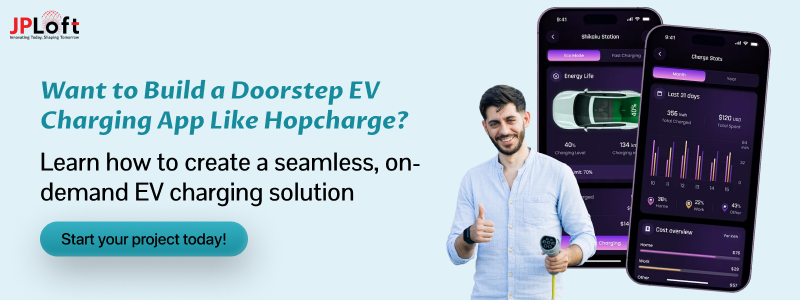
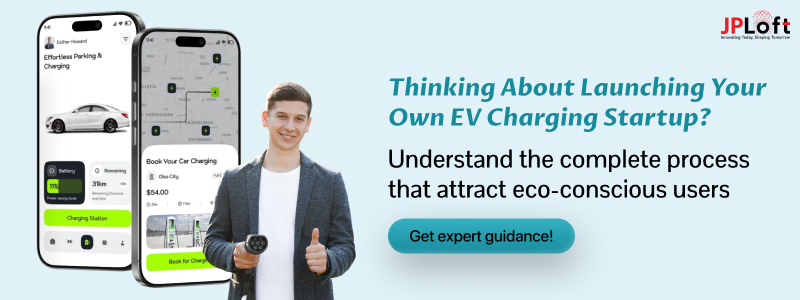

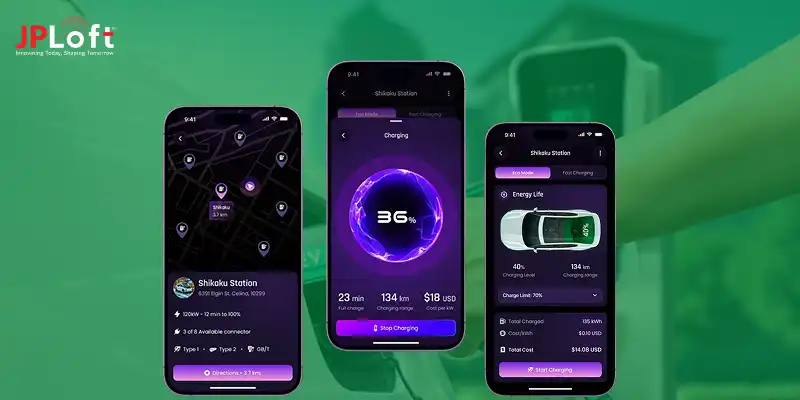
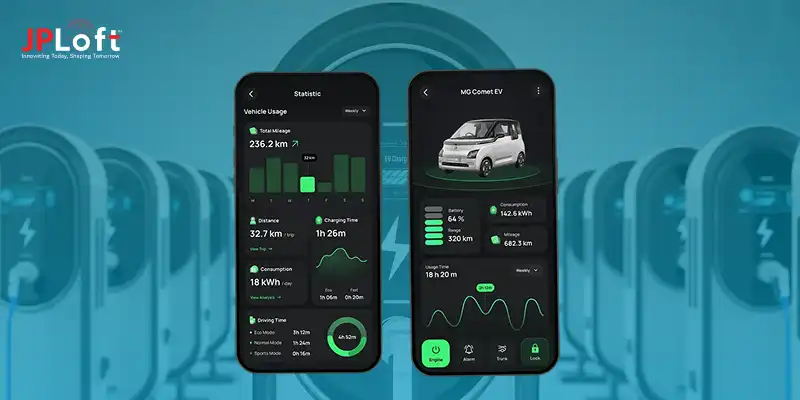
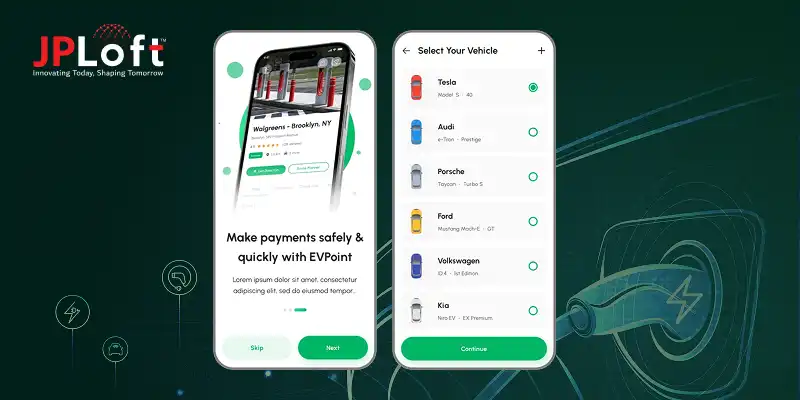


Share this blog